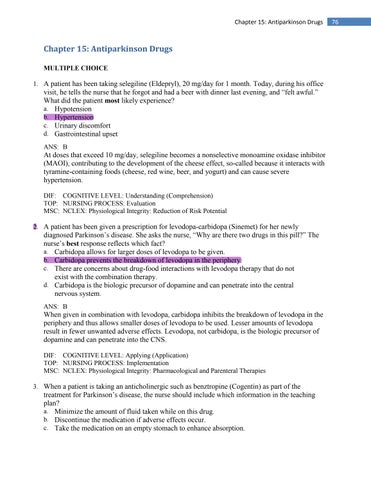Chapter 15: Antiparkinson Drugs
Chapter 15: Antiparkinson Drugs MULTIPLE CHOICE 1. A patient has been taking selegiline (Eldepryl), 20 mg/day for 1 month. Today, during his office
visit, he tells the nurse that he forgot and had a beer with dinner last evening, and “felt awful.” What did the patient most likely experience? a. Hypotension b. Hypertension c. Urinary discomfort d. Gastrointestinal upset ANS: B
At doses that exceed 10 mg/day, selegiline becomes a nonselective monoamine oxidase inhibitor (MAOI), contributing to the development of the cheese effect, so-called because it interacts with tyramine-containing foods (cheese, red wine, beer, and yogurt) and can cause severe hypertension. DIF: COGNITIVE LEVEL: Understanding (Comprehension) TOP: NURSING PROCESS: Evaluation MSC: NCLEX: Physiological Integrity: Reduction of Risk Potential 2. A patient has been given a prescription for levodopa-carbidopa (Sinemet) for her newly
diagnosed Parkinson’s disease. She asks the nurse, “Why are there two drugs in this pill?” The nurse’s best response reflects which fact? a. Carbidopa allows for larger doses of levodopa to be given. b. Carbidopa prevents the breakdown of levodopa in the periphery. c. There are concerns about drug-food interactions with levodopa therapy that do not exist with the combination therapy. d. Carbidopa is the biologic precursor of dopamine and can penetrate into the central nervous system. ANS: B
When given in combination with levodopa, carbidopa inhibits the breakdown of levodopa in the periphery and thus allows smaller doses of levodopa to be used. Lesser amounts of levodopa result in fewer unwanted adverse effects. Levodopa, not carbidopa, is the biologic precursor of dopamine and can penetrate into the CNS. DIF: COGNITIVE LEVEL: Applying (Application) TOP: NURSING PROCESS: Implementation MSC: NCLEX: Physiological Integrity: Pharmacological and Parenteral Therapies 3. When a patient is taking an anticholinergic such as benztropine (Cogentin) as part of the
treatment for Parkinson’s disease, the nurse should include which information in the teaching plan? a. Minimize the amount of fluid taken while on this drug. b. Discontinue the medication if adverse effects occur. c. Take the medication on an empty stomach to enhance absorption.
76

